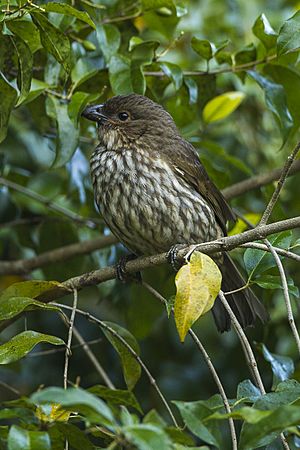Tooth-billed bowerbird facts for kids
Quick facts for kids Tooth-billed bowerbird |
|
|---|---|
 |
|
| Conservation status | |
| Scientific classification | |
| Genus: |
Scenopoeetes
|
| Species: |
dentirostris
|
The tooth-billed bowerbird (Scenopoeetes dentirostris) also known as stagemaker bowerbird and tooth-billed catbird is a medium-sized, approximately 27 centimetres (11 in) long, stocky olive-brown bowerbird with brown-streaked buffish white below, grey feet, brown iris and unique tooth-like bill. Both sexes are similar, however the female is slightly smaller than the male. It is the only member in monotypic genus Scenopoeetes.
An Australian endemic, the tooth-billed bowerbird is distributed to mountain forests of northeast Queensland. Its diet consists mainly of fruits and young leaves of forest trees.
The male is polygamous and builds a display-court or "stage-type bower", decorated with fresh green leaves laid with pale underside uppermost. The leaves are collected by the male by chewing through the leaf stalk and old leaves are removed from the display-court. The display-court consists of a cleared area containing at least one tree trunk used by the male for perching. Upon the approach of a female the male drops to the ground and displays.
A common species in its limited habitat range, the tooth-billed bowerbird is evaluated as least concern on the IUCN Red List of Threatened Species.
- Pizzey, G and Knight, F. (1997). "The Field Guide to Birds of Australia". Angus and Robertson. Sydney.
See also
 In Spanish: Pergolero dentado para niños
In Spanish: Pergolero dentado para niños



